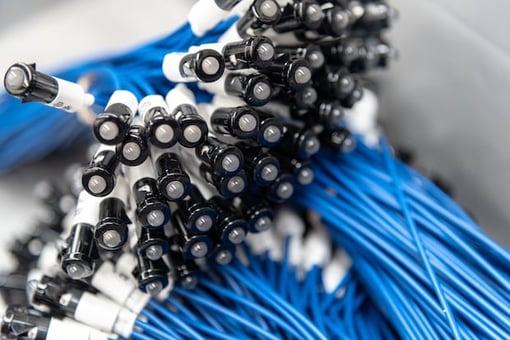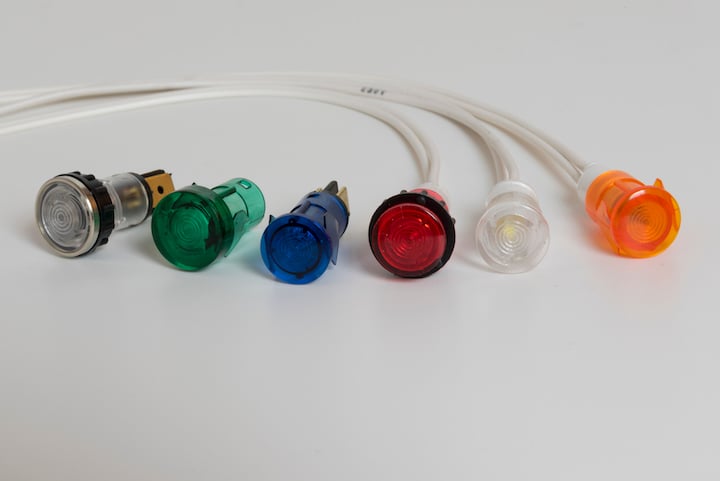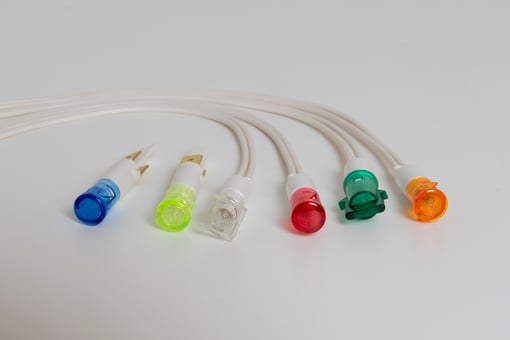Author: Editorial board

Light indicators: an overview to better know this light component
Light indicators act as an indicator of the correct operation, fault or simple status of specific components of machines, instruments or even switches.
The origin of the development of the light indicator can be linked to the growing production of household appliances in the period of the economic boom following WWII; a phenomenon that first involved the United States and then, spread to Europe and, as a result, to the Italian market.
Nowadays, light indicators are used for different purposes in a variety of application fields because they offer many different solutions for multiple requirements and are excellent way to achieve reliable signalling. Here is an in-depth look at this type of light signalling product.
- Light indicators: main features
- Light indicators: from incandescence to LED
- Light indicators for panels
- Light indicators for electrical panels
- Light indicators: the voltage
Are you interested in SLIM components? Click on the button below and download the product catalogue to find out about the technical specifications of the wide offer available.
Light indicators: main features
The term light indicator is strictly related to the signal light, whose function is to display the operating status of a specific application externally.
What are the components of a light indicator? Let's take a look at the main elements:
- Light source: this is the definition of the type of source, bulb or LED, and of the relevant intensity to obtain the best possible result;
- Plastic body: this is the contact point between the signalling device and the application. It can, in turn, consist of one or more parts and its function is to house the internal
- Lens / Diffuser: this allows you to obtain a light effect that varies from a spotlight to a diffused light, lighting or simple signalling, depending on the specific application;
- Connection: this allows the connection between the signalling device and the application on which it is used; it can consist of cables or metal terminals.

Light indicators: from incandescence to LED
Initially, incandescent lamps or discharge lamps (neon/fluorescent) were used as sources and then later, the LED. Choosing the type of source is based on both technical and aesthetic needs. LED light indicators, for example, are recommended for a longer duration of the source compared to other solutions, and for a better aesthetic result.
Whatever solution you opt for, you should bear in mind that each source must be combined with specific components such as diodes, resistors and capacitors, to ensure the correct operation of the light indicator.
These conditions are established during the sampling phase, in which the customer communicates the following information: operating voltage, Alternating Current (AC) or Direct Current (DC), maximum operating temperature, connection with cable or with a 6.3x0.8mm or 4.8x0.8mm faston terminal, colour of the light emitted, type of lamp (incandescent - neon/fluorescent - LED), type of lens (colour, shape and model), required approvals and finally, any other technical specifications, such as the IP rating.

Light indicators for panels
Light indicators for panels can be fixed on the panel using self-locking tabs integrated in the plastic case or diffusion lens or alternatively, using a locking nut positioned inside the panel. The first method allows for faster assembly, while the second is preferable when the light indicator needs to be fastened more securely on the panel (e.g. if an o-ring needs to be secured in place to increase the IP rating of the front panel).
The parameters defining which light indicator is most suited to your application, are the following:
-
the shape and dimensions of the external casing: the shape and dimensions of this template, in which the indicator will be inserted, are very important to ascertain if it is possible to choose a standard solution or if a customised solution is required;
-
the size of the light in the part under the panel: knowing the size of the light allows you to ascertain whether or not it will interfere with the other components in the space;
-
the IP rating of the environment or application in which the light indicator needs to be housed: it is important to take into account whether the light indicator is applied in a particularly humid environment, in contact with water;
-
the degree of impact resistance to aggressive agents: in this case, you can opt for the vandal-resistant version with a metal body and o-ring to guarantee a greater degree of resistance to mechanical and chemical stress.

Light indicators for electrical panels
The light indicator can be used in various application areas: from the lighting sector to HVAC and HO.RE.CA. sector, in particular for coffee machines, as well as the distribution and systems set-up for electrical panels and wiring. The use of LED light indicators is also widely used in the household appliance sector: from cooking to refrigeration, washing machines and dishwashers, as well as in small appliances.
Light indicators are simple and quick devices to be installed on control or electrical panels, and on panels. By light indicators for electrical panels, we mean one of the different applications of the macro-category of panel signalling devices. The choice of the most suitable light indicator for your application is dictated by the specific aspects of the reference sector and final application.
Light indicators: the voltage
Another key variable to take into consideration during the sampling phase is the operating voltage, which can be either alternating current (AC) or direct current (DC). A wide range of voltages is available, from 2V up to 400V, to be decided on when configuring the product. Each type of bulb, however, requires a specific voltage, for example, neon/fluorescent bulbs cannot be used for voltages below 70V, while incandescent bulbs are more suitable for applications below 70V. LEDs can, on the other hand, be used on all voltages without any problems. For a low voltage, they can be chosen for 12volt light indicators, or with higher voltage, as 220V light indicators.
If you are looking for the most suitable light indicator for your application, click on the button below and find out how to configure the product you are interested in.

